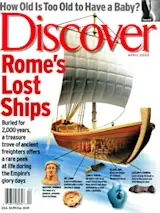Happy days of discovery are the exception, not the rule, for scientists who explore outer space. High-tech satellites and probes are only as good as their fallible engineers, which means textbook triumphs usually come only after repeated battles with Murphy's Law. The Galileo spacecraft, now concluding its remarkable five-year tour of Jupiter and its moons, has just such a dark past. After Galileo's much-delayed launch, dismayed ground controllers discovered that its main antenna had become stuck during the craft's long stay in storage. They frantically reprogrammed the 2.4-ton behemoth so it could relay information through its puny backup antenna, slowly but effectively.
NASA astronauts had to install new optics to correct the Hubble Space Telescope's misshapen mirror. Courtesy: NASA/ SPL/ Photo Researchers
April seems an appropriate time to review the many other blunders behind astronomy's proud achievements. America's first interplanetary pacecraft, Mariner 1, never made it to Venus because someone ...














